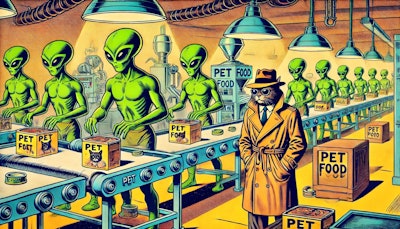
From melamine to vitamin overdoses to drugs and horse meat to DCM, the past few decades have eroded consumers’ confidence in pet food brands and federal regulatory agencies. At the same time, technologies opened new sources for both information and rumors. Internet forums, social media and product reviews can foster community and build trust. Or they can have the opposite effect and become a public courtroom for a pet food brand, leaving a digital stain that can haunt a brand for years. Beyond brand reputation, social media can spread misinformation about pet food, fostering pet owner concerns that may ultimately distort the detection and diagnosis of illness.
At their worst, rumors may overshadow the identification of a health issue’s real cause. If a concern spreads about a particular ingredient or brand being unsafe, pet owners may switch to another formulation regardless of that shift’s effect on their pet’s digestive system and microbiome. Reports associating a pet’s symptoms with a trending rumor could overlook the actual cause of the illness. This "signal noise" can make it harder for pet manufacturers, veterinarians and regulators to identify credible reports. This may delay necessary medical interventions. The proliferation of rumors can also drive resources away from addressing genuine problems as companies spend time managing public perception rather than responding to authentic health and wellness concerns.
A key challenge in this scenario is the rapid spread of misinformation through social media. Pet owners can be quick to share personal experiences without verification, amplifying fear and suspicion. This can obscure data trends that would otherwise signal a real issue. When customers report perceived problems based on rumors, the industry is forced to react to a high volume of inconsistent or false claims, which could mask the detection of a genuine health concern.
Another challenge arises with consumers’ lack of trust for conventional sources of information. The public’s changing perception of brands, the media and the government extends far beyond pet food. Nevertheless, several events have been specifically related to pet food. For example, the Food and Drug Administration (FDA) investigation into canine dilated cardiomyopathy (DCM) and correlations to grain-free diets complicated the relationship between pet owners and official sources of information. Initially, the FDA's announcements raised concerns among pet owners, leading many to question the safety of grain-free formulations and the role of ingredients like legumes in DCM onset.
Pet owners’ changed attitudes to official messages
In July 2018, the FDA publicly announced the agency’s investigation into correlations among certain dog foods and DCM. Federal authorities examined reports of DCM in dogs eating certain diets labeled as grain-free, particularly those containing peas, lentils, other legume seeds, or potatoes as main ingredients, which were more common in diets labeled as grain-free. A year later, the agency released data from their investigation that stated 93% of the 524 reported cases of DCM, involved dog foods made with peas and/or lentils, while 90% of the afflicted dogs had eaten diets labeled as grain-free. The FDA named 16 brands most frequently eaten by dogs involved in official reports of DCM. Sales of grain-free dog food in general, and those named brands especially, fell following FDA’s announcements, while more new products began to include taurine. Pet food companies adapted their marketing while developing new dog foods, treats and toppers specifically meant to ease pet owners' fears of DCM. Instead of claiming that all grains in pet foods were negative, brands became “grain friendly” as they began to include ancient grains or other “healthy grains while continuing to malign conventional grains like wheat and corn.
Although the FDA investigation caused upheaval in the pet food industry, scientists and other involved with the pet food industry have pointed out the lack of direct evidence connecting those grain-free dog foods to DCM, since the first FDA announcement. Likewise, some have criticized the FDA for going public with the investigation before solid evidence existed, especially considering the negative economic consequences for dog food brands. In total, the FDA received 1,382 reports of DCM. In 2022, the FDA stated it had insufficient data to establish causality among DCM case reports and pet food products eaten by afflicted dogs.
Regulatory bodies like the FDA are challenged to balance providing timely warnings with avoiding unnecessary disruption. Conventional news coverage, social media and other electronic sources added to the confusion that average consumers had to navigate regarding DCM. The unclear messages diminished some pet owners' trust in official sources, as they sought alternative information through social networks, online forums or anecdotal advice from fellow pet owners.
While the DCM investigation may not have found evidence of a definitive connection between diet and disease, the 2007 melamine crisis was the opposite.
Melamine and cyanuric acid pet food tragedy
On March 16, 2007, Menu Foods, a contract pet food manufacturer, issued its first recall of cuts-in-gravy-style dog and cat foods. Dogs and cats were dying of kidney failure, but no one knew the cause. The recalls would swell to more than 60 million containers from nearly 100 brands. Superpremium and economy brands alike were involved, but they had one commonality. Most had been thickened with what formulators thought was wheat gluten.
Instead of wheat gluten, the pet foods actually contained wheat flour spiked with melamine and cyanuric acid, industrial chemicals that may have made the flour seem to have the higher protein content of wheat gluten in tests. Neither chemical is highly dangerous alone, but pathologists eventually realized the two made a deadly pair.
After eating that adulterated food, dogs’ and cats’ bodies became chemistry labs where melamine reacted with cyanuric acid to form durable crystals that clogged pets’ kidneys. By April 2007, those crystals had caused kidney failure in 236 cats and 112 dogs, according to a survey of veterinarians by the American Association of Veterinary Laboratory Diagnosticians and Michigan State University. The final number of deaths is unknown, but consumer reports to the US Food and Drug Administration (FDA) suggest that approximately 1,950 cats and 2,200 dogs died.
FDA's Office of Criminal Investigations has since alleged that more than 800 tons of adulterated wheat gluten, valued at nearly US$850,000, came into the United States between November 6, 2006, and February 21, 2007. In February 2008, a federal grand jury in Kansas City indicted three Chinese nationals and a US citizen on multiple counts for importing the melamine-contaminated product and distributing it. Sally Qing Miller, a Chinese national, and American Stephen S. Miller pleaded guilty on June 16, 2009, to their roles as owners of ChemNutra, the company that distributed the tainted ingredient in the US.
Discovering the complex chemical reaction involved in the tragedy didn’t change many pet owners’ own reactions. Before the melamine crisis, many pet owners operated under the assumption that commercially available pet foods were safe, beyond occasional recalls. With so many brands to be involved, pet owners faith in the whole pet food industry and its regulators was shaken. The 2007 melamine crisis remains one of the most pivotal events in the pet food industry's history. The event damaged pet owners' trust with repercussions that continue today. Pet owners demanded more transparency from pet food manufacturers and stricter regulations, particularly of ingredients sourced internationally. The crisis also encouraged the home-prepared pet food movement and the rise in popularity of premium diets as owners sought more control over what their pets consume. Pet owners became more skeptical of messaging from federal agencies and pet food brands.
Transparency builds trust in the pet food industry
To keep skepticism from replacing trust, pet food brands can enhance transparency. In a market where pet owners are increasingly concerned about ingredient sourcing, production practices and food safety, transparency is critical for building consumer trust in the pet food industry. Clear, honest communication about product formulations, sourcing standards and quality control reassures customers that their pets' health is a top priority. When companies are upfront about their processes, including how they respond to product issues or recalls, they demonstrate accountability and integrity. This openness helps alleviate concerns, especially in an era where misinformation can spread quickly. Transparency fosters long-term loyalty, as pet owners feel confident they can trust a brand that consistently shares relevant information.
To help prevent rumors from overshadowing that relevant information and improve the detection of genuine problems, pet food companies actively encourage customers to report any suspected food-related illnesses. Transparency and open communication are essential in this effort. Companies have established clear, accessible channels for consumers to report concerns directly, such as dedicated hotlines, user-friendly online reporting tools or partnerships with veterinary networks. Pet owners need to know that their concerns will be taken seriously and that reporting an issue will contribute to a positive resolution.
Consumer education plays a critical role. Companies can provide resources that help pet owners recognize symptoms of food-related illnesses and understand the difference between a dietary issue and unrelated health concerns. Proactively educating consumers about the importance of reporting illnesses and ensuring they know how to do so will foster trust and improve data accuracy. Transparency about how companies handle illness reports, including follow-up actions and changes made to products or processes, can help build long-term trust. By maintaining open lines of communication and demonstrating accountability, pet food manufacturers can mitigate the impact of rumors and improve their ability to identify and resolve real issues before they escalate into larger crises.



















